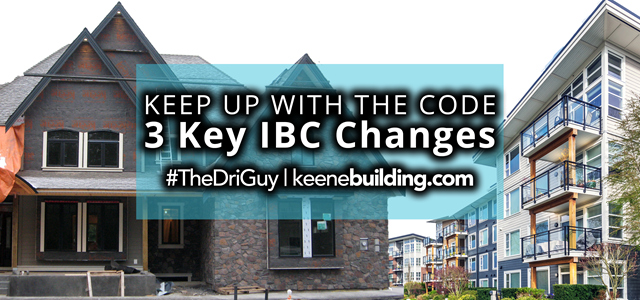
Let’s face it, building codes are constantly changing, and it can be demanding to keep up. However, it is EXTREMELY, critical to remain educated to ensure that your builds are safe, built tight, and constructed correctly. There are many important changes in the International Building Code including “the addition of a 3/16-inch-thick drainage material or open plane between the water-resistive barrier and the cement plaster. This is new. The code does not prescribe how this open plane will be accomplished or maintained. It can be envisioned as an open space between the back of the lath and plaster including any continuous insulation and the face of the water-resistive barrier (Grupe).”
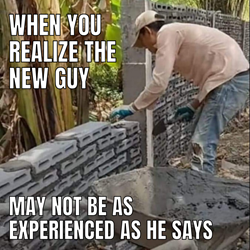 No need to worry about how this open plane can be accomplished. Keene’s got a variety of DriwallTM Rainscreen solutions below.
No need to worry about how this open plane can be accomplished. Keene’s got a variety of DriwallTM Rainscreen solutions below.
Ask anyone in the industry & you are bound to get a multitude of answers referencing things like ASTM standards, IRC requirements, etc. But once you begin to understand the real meaning behind the phrase, it might change the way you view your building standards. Code is the minimum standard. Therefore, building to minimum expectations is no longer acceptable. Especially as home builders, developers, or owners, we expect excellence for the home or build to last a lifetime.
What is new with the International Building Code (IBC)?
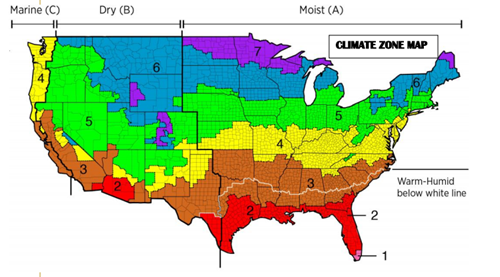
“This change will impact a large portion of the United States. The International Energy Conservation Code divides the United States into climate zones, and the result is that a very major portion of the United States that will fall under the new requirement (Grupe.)”
“The International Building Code (IBC) has introduced "Climate Zones" when selecting the WRB protection for stucco over wood-based sheathing. The intent today has morphed to drainage provisions. The 2021 code (see inset below) has several requirements and exceptions for cement stucco. The SMA has widespread experience with various plaster systems related to water intrusion issues in all Climate Zones (Stucco Manufacturing Association.)”
WHAT ARE THE THREE KEY CHANGES?
- Section 2510.6.1 is DRY climate (Zone B) (8 of 50 states). It requires 2 layers of Weather Resistant Barriers (10 minutes or greater) installed individually. Or Weather Resistant Barrier (60 minutes or greater) separated by a layer of foam plastic or other non-water absorbing layer. Foam in Zones A & C needs some type of drainage plane. -Side Notes: Two layers of WRB is compliant in Zone B. It is also acceptable in Zones A & C with approval.
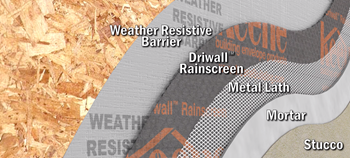
- Section 2510.6.2 is Moist (A) & Marine (C). It requires a layer of Grade D 60 minutes or greater PLUS a minimum 3/16-inch space between the stucco and WRB. If the mat does not have a 3/16" gap, you can still use ASTM E2273 approved rainscreen (Driwall Rainscreen 013). OR one layer of Grade D paper 60 minutes or greater with a drainage space of 90% per ASTM E2273 (Standard Test for Drainage EIFS) or annex 2 of ASTM E2925 (Standard Test for Drainage Mat.
- One layer of any WRB with drainage mat (Rainscreen) is acceptable in all climate zones. Mat must prevent cement (Our Fabric) from filling the void or a 3/16th inch gap.
WHAT MAKES AN EFFECTIVE AIR BARRIER?
- Continuity: no gaps, cracks, or openings.
- Durability: needs to last for the life of the building.
- Repairable: access to repair if damaged.
Keene Building Products has developed two air/water weather barriers, DRIWALL™ AIR WEATHER BARRIER – High Build and DRIWALL™ AIR WEATHER BARRIER – High Perm., to be your solution. Keene’s air weather barriers continuously protect approved substrates from incidental water damage and improve energy efficiency.
KEENE'S WEATHER RESISTANT BARRIER SYSTEM



KEENE'S DRIWALLTM VENTILATION OPTIONS
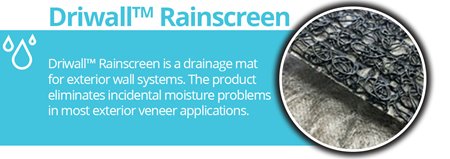
With the increase in building “tightness” for thermal protection, moisture problems are on the rise, causing a greater need for hydrostatic pressure release and a ventilation method. The full-wall DriwallTM Rainscreen product rolls over the water-resistive barrier to separate it from the exterior veneer. The airspace that DriwallTM Rainscreen creates increases airflow through the wall cavity, allowing the wall to breathe and stay dry.
· Keene Building Products offers cost-effective options for every type of cladding.
· Codes are adjusting to include these products in many regions.
· It is the least expensive insurance on the market!
Keene provides a variety of different sizes to accommodate your project needs. The sizes that are available are:
- Driwall Rainscreen 013 (1/8”) | Is used for the installation of manufactured stone and is also used
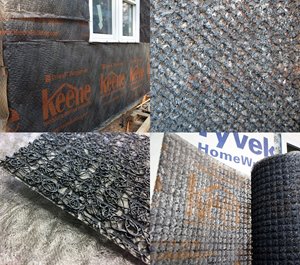 in many 3 coat stucco applications in the Western United States. Newer product for Keene that has been very well received.
in many 3 coat stucco applications in the Western United States. Newer product for Keene that has been very well received.
- Driwall Rainscreen 020 (1/4”) | Is the most universal RainScreen material we produce. This product is used behind a multitude of claddings: Stucco/One Coat and 3 coat. Adhered Veneer Masonry. Cement board, Composite Claddings, and other sidings. Essentially the workhorse of the product line.
- Driwall Rainscreen 10 MM (3/8”) | This material is used both in the United States and is part of the building code through-out Canada. Whether the siding is Stucco, Adhered Masonry Veneer, siding, and/or composite cladding. Provides for maximum drainage efficiencies.
- Driwall Rainscreen 075 (3/4”) | Generally used in unit masonry and stone applications as a full wall rainscreen. Makes mortar bridging virtually impossible.
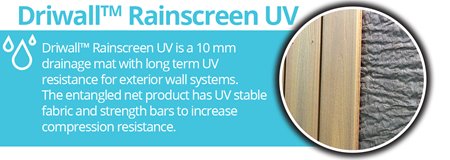
Keene’s Driwalltm Rainscreen UV is designed to provide a 10MM
cavity or 6 MM cavity
with long-term UV Resistance in facades that have open joints exposed to the elements. It has strength bars incorporated into the material to increase compression resistance. The combination of these two characteristics makes Driwall Rainscreen UV ideal and the best choice for open joint claddings. The UV stable fabric is black in color to add contrast to the siding and the entangled net is designed to deter insects. Open joint cladding limitation is a maximum open gap 3/8-inch.
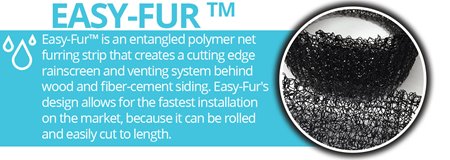
Easy-Fur (3/4”) | A rollable furring strip designed to provide both drainage and ventilation behind cement board sidings. A valuable time saving addition to any projects needing a furing strip. Easy-Fur™ is a 4-inch-wide open weave entangled net that functions just like a conventional furring strip. There is some distinct difference between the Easy-Fur Product. For instance, it can be cut with a scissors or razor knife. It is packaged 25 feet per roll and 4 rolls per bundle. The cost is similar to conventional furring strips and is much faster and easier to install and being open weave will not trap moisture like a wood furring strip could. Plus, the Easy-Fur is multi-dimensional so it works well on vertical sidings as well. Easy-Fur's unique design allows for the fastest installation of any furring strip on the market because it can be rolled on to the wall and easily cut to length.
An air barrier and a rainscreen can prevent structural damage, help keep the air quality clean and the mold out – leaving fewer problems for you and the building occupants. Contact Keene for more information and start using an air weather barrier and rainscreen in your system today.
References:
Association, Stucco Manufacturing. Water-Resistant Barrier for Portland Cement Plaster (Stucco) on Framed Walls, 2021 (b), 2021, doi: https://stuccomfgassoc.com/wp-content/uploads/2021/06/WRB-for-stucco-2021-b.pdf.
Grupe, Robert. “IBC Changes Regarding Exterior Cement Plaster.” AWCI, AWCI Construction Dimensions, Mar. 2021, www.awci.org/media/construction-dimensions/wachuwannano/2557-ibc-changes-regarding-exterior-cement-plaster